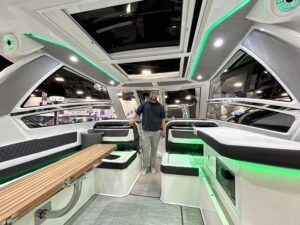By Thomas Motyka ’25
One of my earliest childhood memories is of my dad’s 1969 Correct Craft Mustang, a fiberglass ski boat powered by a Ford 302 V8. With its low freeboard and sleek lines, I thought it was the coolest thing in the world. Truthfully, it was a bit of a clunker with most outings ending with a tow back to the dock. Despite the endless mechanical issues, I was hooked immediately. My passion for recreational boats started at a young age, and I have been fortunate to pursue that interest in my time at Webb.
I spent the winter work term of my senior year as a Naval Architecture Intern at Michael Peters Yacht Design, spending much of my time on structural design and calculations. My biggest project was developing fiberglass laminate schedules and stiffener layups for the deck of a 46-foot express cruiser, the Eclipse 455. This process allowed me to take a lap of the structural design spiral, including weight studies, construction drawings and hydrostatic checks.
 In my time with MPYD I was fortunate to go on a variety of field trips around southern Florida. In my second week of work, a group of us went to check in on the construction of Tribute Custom Boat’s latest build, a 62-foot sportfish. When I visited the hull was just about done, and the crew was landing the lifting strakes on the running surface. On the same trip we attended an open house hosted by Kady-Krogen to see the MPYD designed Summit 54. I got the chance to walk this boat with MPYD’s Senior Designer and Creative Director, where he talked me through many of the challenges they encountered over the course of the design.
In my time with MPYD I was fortunate to go on a variety of field trips around southern Florida. In my second week of work, a group of us went to check in on the construction of Tribute Custom Boat’s latest build, a 62-foot sportfish. When I visited the hull was just about done, and the crew was landing the lifting strakes on the running surface. On the same trip we attended an open house hosted by Kady-Krogen to see the MPYD designed Summit 54. I got the chance to walk this boat with MPYD’s Senior Designer and Creative Director, where he talked me through many of the challenges they encountered over the course of the design.
Later in my internship we travelled to the Miami International Boat Show, where we got to see many of MPYD’s past designs, and do recon for upcoming projects. I got the chance to get aboard the Eclipse 505, the big brother to the 455 which I spent most of my internship working on. As a fun aside, I also got to see the newly debuted Cobalt R35C. I worked on this boat extensively during my junior year internship with Bill Prince Yacht Design.
As a senior I felt prepared for this internship, and I am very grateful for the opportunities I have had in my time at Webb. The Webb curriculum is rooted in building sound engineering principles and then applying them to the marine industry. These practical applications are primarily related to the commercial shipping industry, so it was very cool to apply these engineering principles to the recreational industry. One of the most notable differences between these two sectors of the industry are the materials of choice. Most commercial vessels are made from metal, while most recreational vessels are made from composite materials. Webb’s material science and strength of material courses both address composite materials, but the brunt of the coursework is centered around steel. I developed an interest in composite structures during my junior year at Webb, and this internship with MPYD allowed me to do a deep dive into composites.
In my time at MPYD I also spent some time working with Michael Peters developing a lines plan for a 35-foot sportfish hull. Once again, this allowed me to take the concepts I learned at Webb and expand upon them. While the Webb curriculum mostly addresses the design of slower speed displacement hulls, I got the chance to draw a set of lines for a high-speed planing hull.
I am incredibly grateful to the team at MPYD for being so welcoming, and for teaching me so much in my short time there. I would like to extend a special thank you to Oscar Como ’21 and Robert Maes ’21 for taking me in and showing me around the Sarasota area.
This was my sixth internship in my time at Webb, and as I reflect on my experiences, the biggest piece of advice I can give for students entering internships is to fully commit to being involved. I went to five of my six internships alone, and while challenging at first, this forced me to get comfortable outside of the support network that I found in my classmates at Webb. Jump on every opportunity that you can, make friends with your coworkers, and force yourself to push the limits of your comfort zone.

